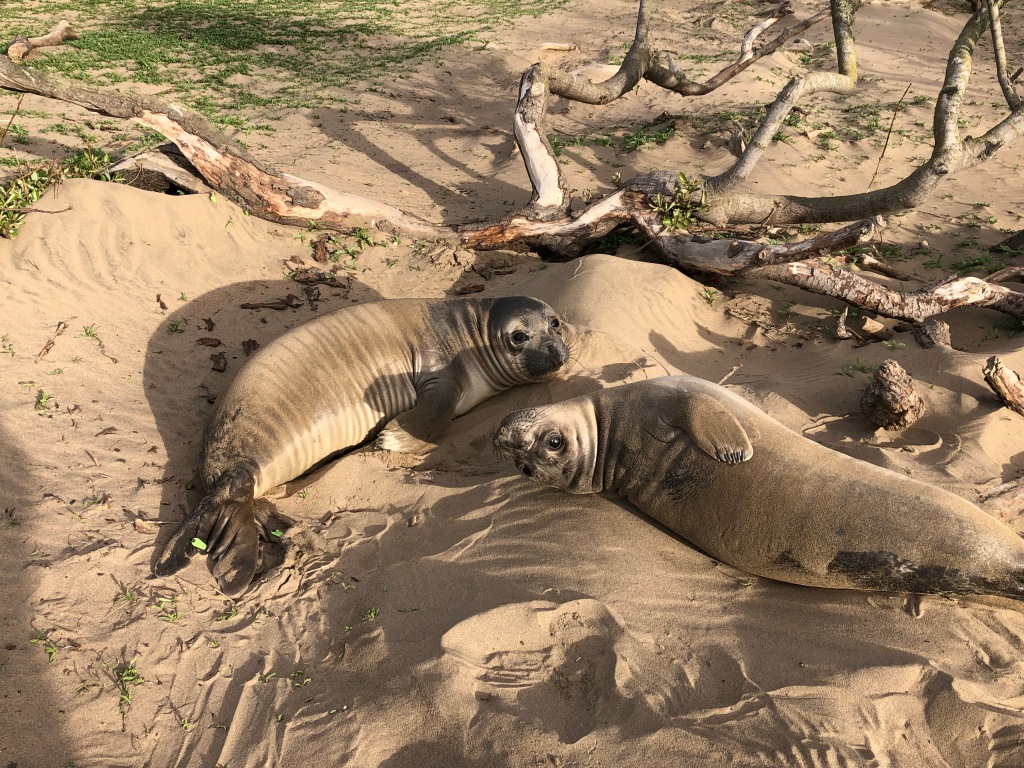
NMFS permit #NMFS 19108
Can you imagine what would happen to your body if you dove up to 1700 meters deep in the ocean for an hour and a half, or experienced months of food deprivation? In the case of deep diving, the high pressure causes the collapse of the lungs of terrestrial mammals (including humans!) and depletion of body oxygen stores, whereas long fasting periods compromise health and induce muscle wasting. Northern elephant seals, however, weather these extreme
conditions routinely without incurring injury. The big question, of course, is: how?

Dr. José Pablo Vázquez-Medina (right), a comparative physiologist at the University of California Berkeley, is interested in elucidating the cellular and molecular mechanisms that allow elephant seals to survive a range of challenging physiological conditions from extended diving at incredible depths to fasting on land for months during energetically-demanding life stages. Dr. Vázquez-Medina’s research group developed an in vitro system to investigate the cellular adaptations at play in elephant seals. They presented their research at the recent 2021 Experimental Biology conference.
To understand how elephant seals tolerate fluctuating oxygen content in their blood during dives, the researchers isolated arterial endothelial cells from elephant seal placentae. In humans, major fluctuations in blood and oxygen delivery are hallmarks of conditions such as heart attacks and stroke. During these adverse events, disruption of blood and oxygen delivery damages the blood vessels as well as downstream organs; blood vessels accrue cellular damage called lipid peroxidation from reactive compounds generated during these fluctuations, which creates “leaky” vessels that can no longer effectively regulate blood pressure and inflammation. In elephant seals, however, these oxygen fluctuations are part of the adaptations that allow them to remain submerged for extended periods of time without access to air at the surface. Kaitlin Allen, Alex Li, and Diamond Luong found that elephant seal endothelial cells maintained viability and were highly resistant to lipid peroxidation when treated with peroxide. They investigated whether elephant seal cells possessed high protein content of the only two enzymes that can repair lipid peroxidation: glutathione peroxidase 4 (Gpx4) and peroxiredoxin 6 (Prdx6). Surprisingly, it doesn’t seem like they do, and peroxide treatment did not induce expression in elephant seal cells – it actually decreased it, and overall peroxidase activity was low in seal cells. This seems to suggest that the cells have another mechanism for dealing with lipid peroxidation that doesn’t rely on repair alone – perhaps rapid scavenging of toxic agents that is proactive rather than reactive.



Pictured above: Kaitlin Allen (left), Alex Li (middle), and Diamong Luong (right)
Elephant seals fast on land during major life stages including breeding, lactation, postnatal development, and molt. In each of these life stages, energy is required to maintain body systems (and in the case of development, to expand them – developing both blood and muscle stores to prepare for diving!). Many mammals utilize energy acquired during feeding to fuel these processes, but elephant seals partake in these stages while physically separated from the
marine environment that contains their food source. Dr. David Ensminger found that fasting elephant seal pups resist oxidative stress and inflammation during activation of the (glucocorticoid-producing) hypothalamic-pituitary-adrenal axis. The lab cultured muscle progenitor cells (myoblasts) extracted from seal muscle biopsies to investigate how elephant seals protect their muscles from wasting during extended exposures to dexamethasone, a synthetic glucocorticoid which activates the cellular stress response. Dr. Julia Maria Torres Velarde differentiated these cells in the lab, obtained contractile myotubes (muscle fibers) and exposed both the progenitor cells and the differentiated muscle fibers to dexamethasone. She found that the elephant seals muscle cells tolerate high concentrations of glucocorticoids without compromising cell survival. In fact, the cells shifted their metabolism toward glycolysis in a phenomenon called the Warburg effect, which is present in most types of cancer cells. This change was accompanied by modifications in mitochondrial morphology and a reduction in interactions between the mitochondria and another organelle, the endoplasmic reticulum. Emily Lam, a PhD student in the lab, is developing a method for the reprogramming of dermal fibroblasts into muscle progenitor cells to facilitate similar studies in whales, since the
collection of muscle is challenging or impossible in these animals.



Pictured above: Dr. David Ensminger (left), Dr. Julia Maria Torres Velarde (middle), Emily Lam (right)
Identifying the mechanisms and molecular networks that allow elephant seal tissues to experience – and thrive under – extreme physiological conditions as part of both diving and fasting can potentially open the door to new therapeutic targets for the prevention and treatment of human diseases that affect vasculature health and muscle wasting.
- Q&A with Anthony J. Basile: Please do not feed the birds? – Effects of an urban diet on mourning doves
- Why shrews don’t need sweaters
Categories: Comparative Physiology, Diet and Exercise, Exercise, Extreme Animals, Hibernation and Hypoxia, Nature's Solutions, Ocean Life
Tags: American Physiologucal Society, atrophy, cardiovascular disease, diving, Exercise, Experimental Biology, fasting, hypoxia, muscle, ocean
